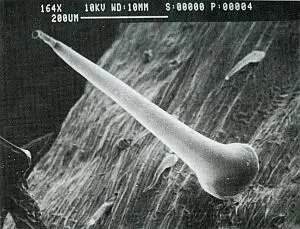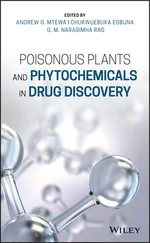Contact-Poisonous Plants of the World
M. Rohde
Plants make use of different techniques to scare away unwanted visitors. The plants in the guide below are marked with symbols to indicate the techniques:

The most obvious defence mechanism a plant can use is mechanical , for example prickles, thorns, or barbs. Less visible but also purely mechanical are the sharp edges of certain grasses which can cause unpleasant cuts. Bamboos also belong to the botanical family of grasses, and some bamboo species bear thin bristles on the surface which can penetrate the skin and cause itching and irritation. There is an exceptional lot of mechanically active plants, and although injuries of the skin can cause secondary infections when dirt enters the human body, the mechanical principle is not subject of this document. Only the malicious and widespread Opuntia with its almost invisible, easily breaking off barbs is included in the list below.

The chemical agents of some plants are poisons that can enter the skin without mechanical action. When the sap of some species gets onto the skin surface it can lead to painful skin irritation or irreversible damages. Some species can even cause temporary or permanent blindness if a person touches broken parts of the plant and then the own eyes. Throwing such plant material into a fire can also be dangerous as the smoke can irritate the skin or also lead to blindness. Typical representatives of this principle belong to the Euphorbiaceae family. There are many members of other botanical families, however, that act similar. Another kind of plants like the Upas tree contain sap that is not skin-irritating but can be fatal if a very small amount of it gets into the bloodstream, for example through minor skin injuries.

The phototoxic principle occurs in a number of plants of which the best example is the Giant Hogweed. Phototoxic poison acts chemically, but only if the skin is exposed to sunlight at the same time.

A more sophisticated principle is the mechanical-chemical one: Plants penetrate the skin of the victim mechanically and introduce a poisonous chemical. The result is often immediate burning sensation of the skin. The best known representative of this kind of plants is the Stinging Nettle. Its closely related species are native to all parts of the world. Most mechanically-chemically acting plants belong to the botanical families Urticaceae and Euphorbiaceae , some of them being much more powerful than the Stinging Nettle. Under an electron microscope, fragile hollow needles become visible with nettle cells at their bases, filled with liquid poison. When touched, the needles break off, leaving oblique tips which can enter the human skin like syringes and release the poison.

Electron-microscope image of a stinging hair of Urtica dioica . Image: Y. Sell.

Another powerful principle, the allergizing principle, is found mainly in members of one botanical family called the Anacardiaceae . Infamous examples are the Toxicodendron species native to North America. The first encounter with one of them usually does not have any noticable consequences. But it allergizes the victim, and any subsequent contact can cause gradually more severe skin irritation.
After skin contact with one of the plants described here, typical symptoms are burning, redness, itching, swelling, or development of blisters. Chemical contact poisons are often oily substances which do not evaporate and thus can contaminate equipment for years. The poisons can be spread across the skin by scratching or they can get into the eyes when the eyes were rubbed with hands. People do react differently to the poisons and the effect of contact poisons is often increased when a person is exhausted or sweating. Washing with water and soap is generally a good idea. If stinging hairs or bristles are on the skin, they should first be removed with adhesive tape or tweezers. In severe cases a doctor must be consulted.
Geographical Distribution
For travellers, the danger of contact-poisonous plants depends on the region visited. The more harmful allergizing Toxicodendron species are native to North America, while the powerful mechanically-chemically active Dendrocnide species are mostly found in Australia. These are regions with highly efficient prevention and information distribution. However, it is the tropics where the most powerful contact-poisonous plants occur in great variety.
Plants which are not native to a region but have been introduced are marked with an asterisk(*).
Cnidoscolus stimulosus
Cyanophyta (in water)
Heracleum mantegazzianum
Laportea canadensis
Metopium toxiferum (Southern USA)
Toxicodendron spp.
Urtica spp.
Cyanophyta (in water)
Heracleum mantegazzianum
Opuntia spp. (Southern Europe)*
Urtica spp.
Cyanophyta (in water)
Toxicodendron vernicifluum
Urtica spp.
Anacardium occidentale *
Cyanophyta (in water)
Dendrocnide spp.
Excoecaria agallocha
Laportea spp.
Mucuna spp.
Opuntia spp. *
Urtica spp.
Central and South America
Anacardium occidentale
Croton ciliato-glandulosus
Cyanophyta (in water)
Dieffenbachia spp.
Excoecaria agallocha
Hippomane mancinella
Hura crepitans
Jatropha urens
Metopium toxiferum
Mucuna spp.
Opuntia spp.
Urera baccifera
Urtica spp.
Anacardium occidentale *
Cyanophyta (in water)
Excoecaria agallocha
Laportea spp.
Mucuna spp.
Opuntia spp. *
Smodingium argutum
Urtica spp.
South and South-East Asia
Anacardium occidentale *
Antiaris toxicaria
Cyanophyta (in water)
Excoecaria agallocha
Girardinia leschenaultiana
Gluta renghas
Hippomane mancinella *
Holigarna arnottiana
Hura crepitans
Laportea spp.
Melanorrhoea spp.
Mucuna spp.
Opuntia spp .*
Semecarpus spp.
Swintonia floribunda
Tragia spp.
Urtica spp. (in mountains)
Guide to Contact-Poisonous Plants
Читать дальше


















